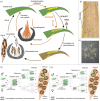Non-Mendelian transmission of accessory chromosomes in fungi
- PMID: 35881207
- PMCID: PMC9508043
- DOI: 10.1007/s10577-022-09691-8
Non-Mendelian transmission of accessory chromosomes in fungi
Abstract
Non-Mendelian transmission has been reported for various genetic elements, ranging from small transposons to entire chromosomes. One prime example of such a transmission pattern are B chromosomes in plants and animals. Accessory chromosomes in fungi are similar to B chromosomes in showing presence/absence polymorphism and being non-essential. How these chromosomes are transmitted during meiosis is however poorly understood-despite their often high impact on the fitness of the host. For several fungal organisms, a non-Mendelian transmission or a mechanistically unique meiotic drive of accessory chromosomes have been reported. In this review, we provide an overview of the possible mechanisms that can cause the non-Mendelian transmission or meiotic drives of fungal accessory chromosomes. We compare processes responsible for the non-Mendelian transmission of accessory chromosomes for different fungal eukaryotes and discuss the structural traits of fungal accessory chromosomes affecting their meiotic transmission. We conclude that research on fungal accessory chromosomes, due to their small size, ease of sequencing, and epigenetic profiling, can complement the study of B chromosomes in deciphering factors that influence and regulate the non-Mendelian transmission of entire chromosomes.
Keywords: Accessory chromosomes; Disomy; Fungi; Meiotic drive; Non-Mendelian transmission.
© 2022. The Author(s).
Conflict of interest statement
The authors declare no competing interests.
Figures


Similar articles
-
Meiotic drive of female-inherited supernumerary chromosomes in a pathogenic fungus.Elife. 2018 Dec 13;7:e40251. doi: 10.7554/eLife.40251. Elife. 2018. PMID: 30543518 Free PMC article.
-
Meiosis Leads to Pervasive Copy-Number Variation and Distorted Inheritance of Accessory Chromosomes of the Wheat Pathogen Zymoseptoria tritici.Genome Biol Evol. 2018 Jun 1;10(6):1416-1429. doi: 10.1093/gbe/evy100. Genome Biol Evol. 2018. PMID: 29850789 Free PMC article.
-
Chromosome-length polymorphism in fungi.Microbiol Rev. 1995 Dec;59(4):686-98. doi: 10.1128/mr.59.4.686-698.1995. Microbiol Rev. 1995. PMID: 8531892 Free PMC article. Review.
-
Non-Mendelian segregation and transmission drive of B chromosomes.Chromosome Res. 2022 Sep;30(2-3):217-228. doi: 10.1007/s10577-022-09692-7. Epub 2022 Jun 3. Chromosome Res. 2022. PMID: 35657532 Review.
-
Meiosis drives extraordinary genome plasticity in the haploid fungal plant pathogen Mycosphaerella graminicola.PLoS One. 2009 Jun 10;4(6):e5863. doi: 10.1371/journal.pone.0005863. PLoS One. 2009. PMID: 19516898 Free PMC article.
Cited by
-
Meiotic segregation and post-meiotic drive of the Festuca pratensis B chromosome.Chromosome Res. 2023 Sep 2;31(3):26. doi: 10.1007/s10577-023-09728-6. Chromosome Res. 2023. PMID: 37658970 Free PMC article.
-
Horizontal transfer of accessory chromosomes in fungi - a regulated process for exchange of genetic material?Heredity (Edinb). 2025 Feb 10. doi: 10.1038/s41437-025-00746-0. Online ahead of print. Heredity (Edinb). 2025. PMID: 39929992
-
Dynamic meiotic behavior and evolutionary insights of supernumerary B chromosomes in the hangingfly Bittacuscirratus (Mecoptera, Bittacidae).Comp Cytogenet. 2025 Jun 4;19:91-107. doi: 10.3897/compcytogen.19.153340. eCollection 2025. Comp Cytogenet. 2025. PMID: 40510269 Free PMC article.
-
Transposons and accessory genes drive adaptation in a clonally evolving fungal pathogen.Nat Commun. 2025 Jul 30;16(1):6982. doi: 10.1038/s41467-025-62213-y. Nat Commun. 2025. PMID: 40739135 Free PMC article.
-
Comparative genomics of Cryptococcus and Kwoniella reveals pathogenesis evolution and contrasting karyotype dynamics via intercentromeric recombination or chromosome fusion.bioRxiv [Preprint]. 2024 Jan 13:2023.12.27.573464. doi: 10.1101/2023.12.27.573464. bioRxiv. 2024. Update in: PLoS Biol. 2024 Jun 6;22(6):e3002682. doi: 10.1371/journal.pbio.3002682. PMID: 38234769 Free PMC article. Updated. Preprint.
References
Publication types
MeSH terms
LinkOut - more resources
Full Text Sources

